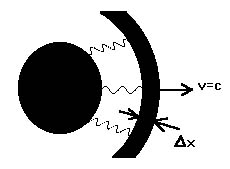Does E=mc2? Probably, but no thanks to Einstein. In 1804 J. Soldner
attributed to light a mass and thereby calculated light's gravitational
deflection.1 Likewise, John Mitchell using Newtonian gravity acting on a
corpuscle of light, deduced the escape velocity, and thereby the critical
mass and radius, of a star that would emit no light [i.e., a black hole
—Ed]. Mitchell reported his findings to the Royal Society of London on
27 November, 1783. One can find E=mc2 hidden in various works,
usually associated with the index of refraction of light, or electrical
capacitance, or both. For example, we find it in the works of Oliver
Heaviside which works have been discovered in recent years; and also in
James Clerk Maxwell's theoretical investigations on the electromagnetic
theory of light.2
The usual derivation of E=mc2 uses the following sloppy mathematics,
about which the student must not murmur. (Actually, no student
dares question this most sacred amongst sacred cows.)
and what is not kinetic energy [(1/2)mv2] is something else, and that
something else is the famous E=mc2. But the third quality [right-hand
side, first line above — Ed.], is not an equality. Relativistic enthusiasts
are always letting things move at velocities approaching the speed of
light (c), but note the rotten approximation obtained from the first two
terms of the appropriate binomial expansion (Taylor series, if you like):
But the energy associated with this motion is:
Once relativists slip (1+v2/2c2) by you, they get clocks to slow down,
measuring rods
to shrink, and other Alice-in-Wonderland things by somehow
replacing v2 in this expression by whatever man can grab, e.g., see
Humphrey's wonders when he sticks in F (p. 101, Starlight and Time,
Master Books). 1 2
(1-v2/c2)-1/2 (1+v2/2c2)
When E=mc2 is used, it is benignly used as an exact expression of physical
fact, not rudely spoken of as an approximation; a bad one at that.
v=0.5c 1.1547 1.1250
v=0.9c 2.2941 1.4050
v=0.95c 3.2026 1.4512
 Let me add my school-boy
derivation of E=mc2 which at
least bears somewhat in some
way on the physics of the matter
and avoids the perplexing
notion of converting matter to
energy (whatever that means).
Consider a blob of mass
radiating (giving off) things
called photons (Figure 1), and
let them be given off by shells
of thickness Dx and moving
out from the blob at velocity v=c.
Let me add my school-boy
derivation of E=mc2 which at
least bears somewhat in some
way on the physics of the matter
and avoids the perplexing
notion of converting matter to
energy (whatever that means).
Consider a blob of mass
radiating (giving off) things
called photons (Figure 1), and
let them be given off by shells
of thickness Dx and moving
out from the blob at velocity v=c.
Assuming that Newton got F=ma right, we write the force on the shell as: